Art World
Memes Are Dominating Attention Spans and Clicks Like Never Before. So Why Is Serious Socially Engaged Art Also Thriving?
Read an excerpt from the new book "More Art in the Public Eye."
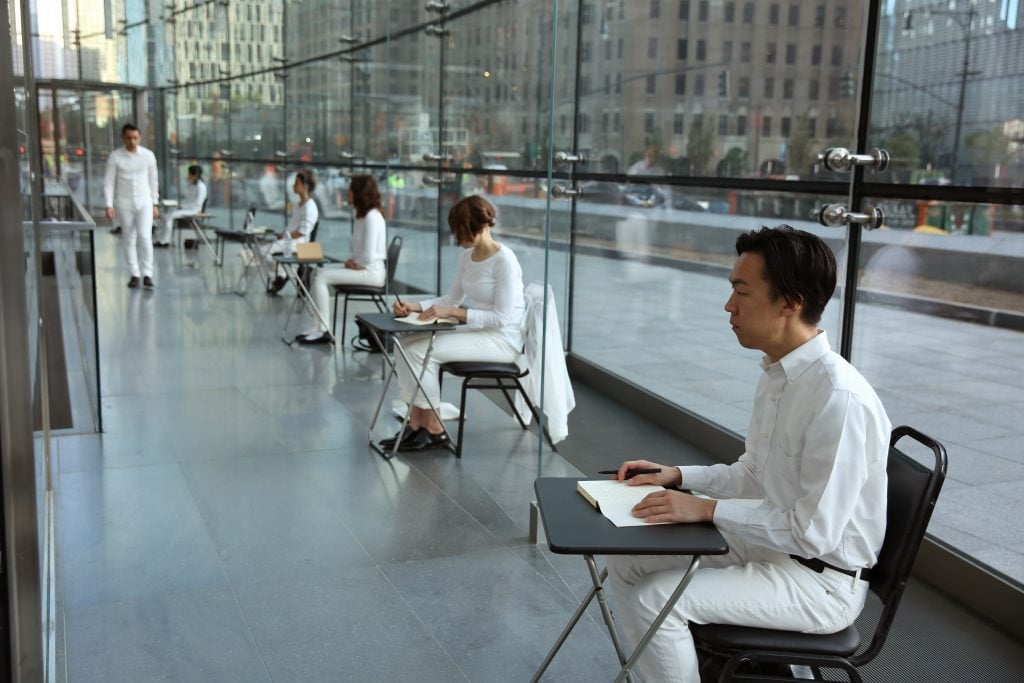
Read an excerpt from the new book "More Art in the Public Eye."

Gregory Sholette

A mohawk-topped black man defiantly marches forward across a public plaza as a weaponized water cannon blasts him back, creating a visceral spectacle recalling civil rights confrontations in 1960s Birmingham, Alabama, but the year is really 2014, and the place is New York City. A series of free workshops teaches eager participants the art and history of protest songs, all the while repurposing such musical dissent to accommodate issues of contemporary resistance. A mysterious huddle of white-clad scriveners silently documents the routine behavior of urban passersby, including those everyday acts of drudgery, pleasure, and resistance that theorist Michel de Certeau described as the “murmuring voice of societies.” Who are these persons, agents, performers? What do they want? And how did they and their projects materialize in the city’s public spaces?
Three projects by three artists—Dread Scott, Pablo Helguera, and Ernesto Pujol—all set against a backdrop of routine unfreedom, were each developed in an effort to foster creative collaborations between communities and artists. It is an objective especially suited to our times, when the very term “art” is radically shifting, twisting, inverting, if not undergoing an outright self-expulsion by moving out of its familiar dwelling places to occupy the public sphere at an ever-accelerating tempo. Unavoidably, as art joins in the everyday social world, its status as a privileged realm, set apart from the ubiquitous materialistic pursuits of consumer society, is likewise receding from view. This essay argues that this trade-off is one that artists and critics have yet to really confront, especially if they wish to remain relevant in a world of Lolcats, Doomsday preppers, and xenophobic frog memes.
We are witnessing today the full-on return of socially engaged cultural activism, not only amongst embedded movement artists and community-based cultural workers, but by professionally trained, MFA-bearing artists who refuse the conventional opposition separating art from politics, from current events, and from life in general. Decades of work by artists such as Scott, Helguera, and Pujol (and many others) now serves as inspiration for this emerging cultural shift that concurrently loops back to energize their own creative practices.
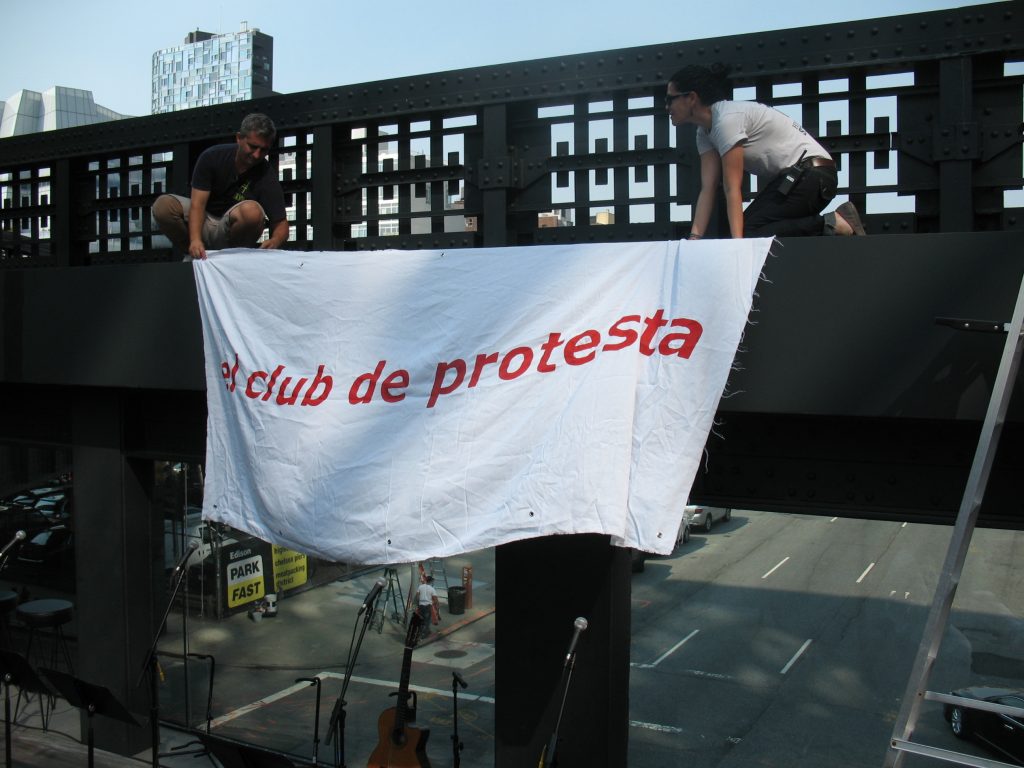
For El Club do Protesta/The Protest Club (2011), senior citizens studied and adapted traditional protest songs from Latin and North America in a series of workshops with Pablo Helguera and professional musicians, culminating in
performances on Manhattan’s High Line. Photo by More Art.
This new wave of cultural activism ranges from the deconstructive installations and raucous performances of Debtfair, who collectively call out the intolerable burden of overextended credit obligations suffered by students, artists, and workers, to the visually bracing public interventions of Decolonize This Place, who stage confrontations over issues such as anthropological bigotry at the American Museum of Natural History and the ethical challenges represented by board members of the Whitney Museum. Since the murder of Michael Brown in Ferguson, Missouri, on August 9, 2014, the activist coalition Black Lives Matter has mobilized many artists who are infuriated by police shootings of unarmed African American people. Meanwhile, in the UK, the group Liberate Tate managed to wean the London-based museum off British Petroleum’s addictive feed of petrodollars.
Especially since the 2008 financial crash, we have seen a surge of creative hybrid art and activist experiments that address fair labor practices within the multimillion-dollar art world, by groups such as Working Artists for the Greater Economy (WAGE), Occupy Museums (Debtfair, mentioned above, is a facet of their work), and the multilevel tactical interventions of Gulf Labor/Global Ultra Luxury Faction (GULF), who have targeted Guggenheim museums in New York and Venice, Italy, with boycotts, occupations, and charges of abuse towards migrant laborers in Abu Dhabi, the site of a future Guggenheim outpost, presently on hold. Recently the staff of the New Museum successfully voted to form a union, despite overt efforts by administrators to stop them.
Still, what makes this return of a highly politicized cultural consciousness so very robust and far-reaching today? After all, the post-war fusion of art and politics was fully mapped out between 1968 and 1984, from the uprisings of the New Left across the globe, to post-colonial and identity liberation movements, to mass resistance against Ronald Reagan’s push to invade Nicaragua and station tactical nuclear missiles in Turkey. Is it this historical precedent? Or a certain pedagogical influence from one generation to another? Advances in communications technology? Or is it something new and unprecedented in our present moment? And why is this burst of socially committed culture taking place as the very category of art as autonomous object is dissolving from view, but also as the regressive forces of nationalism, racism, and misogyny are dangerously gaining in strength across the globe?
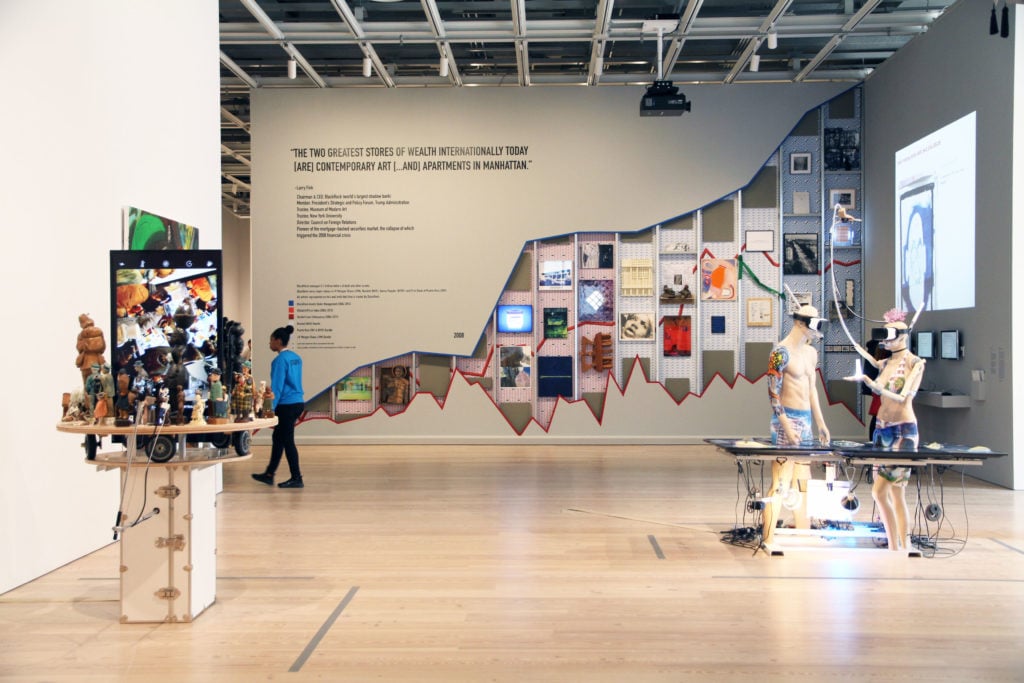
Occupy Museums, Debtfair (2017). Photo: Henri Neuendorf.
Let’s begin with a hypothetical genealogy of activist art, one that for practical reasons is focused primarily on post-1968 New York City. This alternative art-historical chronicle flows forward from the anti-Vietnam War demonstrations of the Art Workers Coalition, Black Emergency Cultural Coalition, and Guerilla Art Action Group in the late 1960s, through such informal collectives as Artists Meeting for Cultural Change and the Real Estate Show in the 1970s. Group Material, Political Art Documentation/Distribution, the Guerilla Girls, Gran Fury, and Critical Art Ensemble emerged in the next decade, followed by the rise of “tactical media” in the 1990s and 2000s with Electronic Disturbance Theater, Center for the Tactical Magic, and RTmark and The Yes Men, whose digital mimesis, “intelligent sabotage,” and corporate “identity correction” characterizes much of this work. Though these antecedents aggregate into a definite and determinate argument, they do not fully explain current circumstances.
Pedagogy also plays a role in our brief analysis. Since the turn of the last century, we find an ever-expanding explosion of seemingly spontaneous collectivism and cultural activism amongst younger artists, graduates of MFA programs taught by studio faculty who made it their mission to intentionally pry open standard formalist art-historical narratives, in order to insert social and political motivation into traditional art-for-art’s-sake curricula. And yet the influence of these progressive art educators does not fully account for the accelerating wave of militant cultural activism over the past couple of decades. Dare we consider technology as its primary booster?
Permeating the 1990s and early 2000s was an alluring techtopian enchantment brought about by increasingly accessible social communication networks. When coupled with the implosion of the sclerotic socialist eastern bloc, as well as with the charismatic cyber-tactics of Mexico’s EZLN (Zapatista Army of National Liberation), it suddenly seemed that “Another World is Possible.” Adopted in 2001 by the first World Social Forum for civil society and social justice in Porto Alegre, Brazil, the phrase also became a mantra for the counter-globalization movement reaching from Seattle to Genoa. Improvising with only half-hearted irony on this speculative futurity, cultural theorist Gene Ray proposed in 2004 that “Another (Art) World is Possible,” carefully though clearly surfing the wave of optimism launched by new globally connected communications media.
And it was unquestionably a remarkable moment. For a time it seemed possible to speak about an alternative mode of globalization that would be fundamentally different from the blanket monetization of the planet dreamt of by transnational corporations. In just such an ecstatic vein, Harvard law professor Lawrence Lessig opined buoyantly:
[digital] technology could enable a whole generation to create—remixed films, new forms of music, digital art, a new kind of storytelling, writing, a new technology for poetry, criticism, political activism—and then, through the infrastructure of the Internet, share that creativity with others.
But before long, post-9/11 Patriot Act restrictions tarnished the Wild West allure of early cyberspace, which was further crippled by increasing legalization, consolidation, and rapid commercialization of Internet platforms. The dream of direct digital democracy did not die so much as deflate, only to be reanimated as increasingly specialized, even sectarian, subscriber sites, internally horizontal, yes, but thoroughly disconnected from any lingering promise of an open-source, global infrastructure where everyone could share their unbridled creativity (above all think here of Facebook). Next came the cold gray “new” reality of the jobless future, an existential shockwave from the 2008 financial collapse that all but demolished the liberatory expectations of the “creative class,” at least as anticipated by neoliberal urban management guru Richard Florida. Still, resistance abhors an aspirational vacuum.
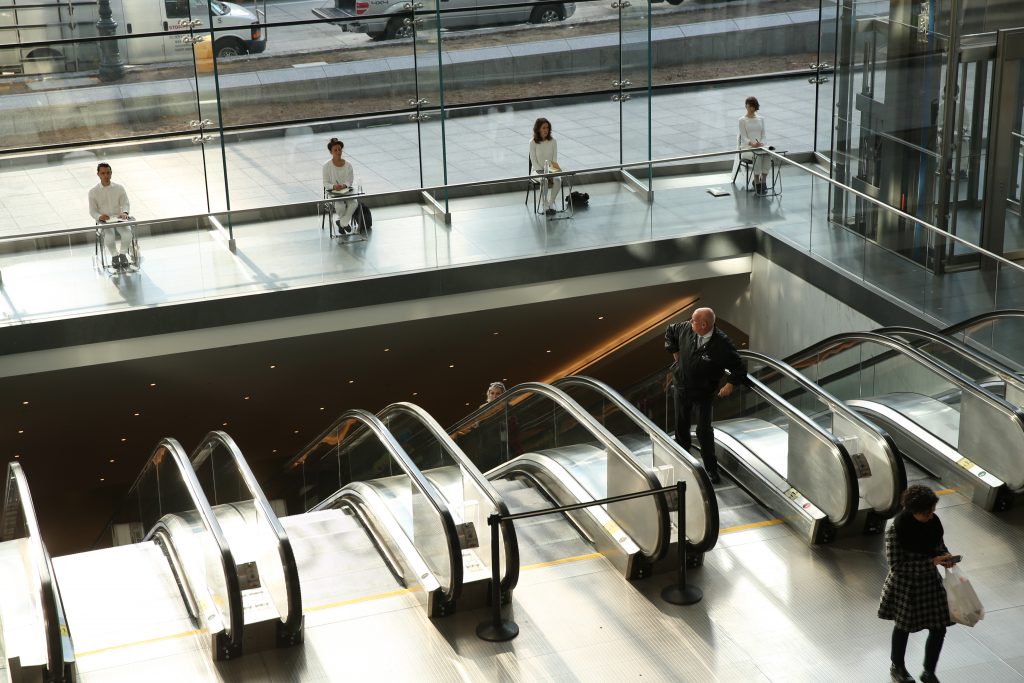
Ernesto Pujol’s performance 9-5 (2015). © Nisa Ojalvo 2015.
Like a sonic boom following a speeding jet, several years after the global financial collapse came the angry, bold, as well as joyful resistance that erupted in 2011 into urban squares, as citizens of the so-called “creative class” congealed into occupying, unemployed armies from Tahrir Square, Cairo, to Puerta del Sol square in downtown Madrid and to Zuccotti Park in New York City. The spark soon spread across the US and Europe, into Russia and to Hong Kong and other parts of the Middle East. Brimming with improvised speeches, DIY music, social choreography and the “human mic,” these occupations shared an overarching sense of collective expectation, each city’s encampment germinating its own low-tech dissident culture made up of handmade cardboard signs taped together or trimmed down, or simply folded into manageable dimensions to maximize protest visibility.
This corporeal dissidence was also streamed online, thus mixing up digital media’s advantages with actual bodies in the street, as if suggesting that some small part of the 1990s techtopia was still alive, though now curiously taking a backseat to a host of obsolete protest media, from picket signs and banner drops to defiant public processions physically blocking traffic. Still, this marriage of low- and high-tech forms was not unprecedented—one need only recall the motto of early 20th-century avant-garde Russian artist Vladimir Tatlin: “not the old, not the new, but the necessary.” And yet, at this point in our hypothetical genealogy of cultural activism, we began to see stirrings of something unexpected, if not entirely novel, because these swarms of semi-organized resistance also contained a strain of regressive cultural opposition that commingled and competed with progressive protesters for visibility and dominance within the media-enhanced theater of discontent.
While the left and right most often expressed opposite positions (though at other times shared nearly identical views regarding questions of governance, democracy, identity, and most of all globalization), this paradoxical phenomena of commingling was perhaps most palpably present in February 2014 during the so-called EuroMaidan uprising in Kiev, Ukraine, when the population occupied and barricaded the city’s central plaza in protest of the government’s shift away from ties with the European Union and towards Putin’s Russia. In that embattled town square, known locally as Maidan Nezalezhnosti, or Independence Square, liberals, conservatives, and several far-right parties briefly cohabited. All of this took place despite the occupiers’ contradictory ambitions regarding neoliberal markets vs. social democracy, and the establishment of secular governance vs. a form of Christian nationalist authority. As strange as that was, today when we look to Brexit and the 2016 US election results, we can see that there is a continuum moving forward from EuroMaidan to the current political situation, as anti-globalist forces, once viewed primarily as a phenomenon on the political left, meld with, or are replaced by, conservative, but also extreme-right, protestors. Put differently, this seeming historical and political anomaly has its own ludicrous logic.
Further muddying post-Internet expectations for the spontaneous emergence of a pro-humanist cybercommons has been the recent phenomenon of bigoted, alt-right websites including 4chan, and the even more grotesque and misogynist 8chan. All the same, even such racist, nationalist, or post-human imaginaries do not forgo all utopian longing, and offer some degree of physiological comfort to the chronically alienated individual. The need to push back against chronic unfreedom has thankfully given birth to countless politically progressive online platforms, but also millions of spritely Instagram posts featuring amusing household pets, impudent children, and electro-comical faux pas spoken by Alexa and her AI kin, along with the inverted dystopian conspiracies such as pedophilic pizza parlors and fake gun survivors paid to denounce the National Rifle Association.
Silly, paranoid, fascist—these defense mechanisms may all be a far cry indeed from the promised dawn of the digital neo-enlightenment foreseen by Lessig and other techtopian dreamers almost two decades ago (though it now feels more like a century has passed since then). Still, the unconcealable contradictions that today result from dramatic climate-change–induced weather, staggering income asymmetries, structural xenophobia, anti-Semitism, Islamophobia, and racism, but also the dreaded emergence of a total surveillance state are always only a swipe or click away, thanks to the more than seven billion mobile devices that link our neural pathways together in the glimmering global matrix of fear, hope, longing, and connectivity, where instantaneous clickable consumption offers partial, though only temporary, satisfaction.
Within this multi-pixelated contemporary world, we can no longer count on art’s once radical autonomy to set its practice apart from other forms of production, exploitation, and fear. When everything is spectacularized, monetized, and brandable, the realm of fine art is left undefended against the voracious appetite of affective capital. We have entered the era of what I call Bare Art. It is an unsettling moment when the institutions and practices of high culture continue to subsist as such, and yet where art is now bereft of mystery, depth, aura, and all those curious traits that once made art appear to operate in an exceptional state, autonomous and detached from the vulgarities of the marketplace. Nevertheless—and this is one more paradoxical wrinkle in this game—high art’s peculiar social license to misbehave, to imitate or even mock reality, to blur genres and disciplines has not vanished, but instead has been simultaneously amplified and decentralized as this contrarian aesthetic value is now imputed to almost everything that jumps, pops, and flows across our glow-screen–bedazzled collective attention span. And it is precisely from this weakened state that new strengths must emerge.
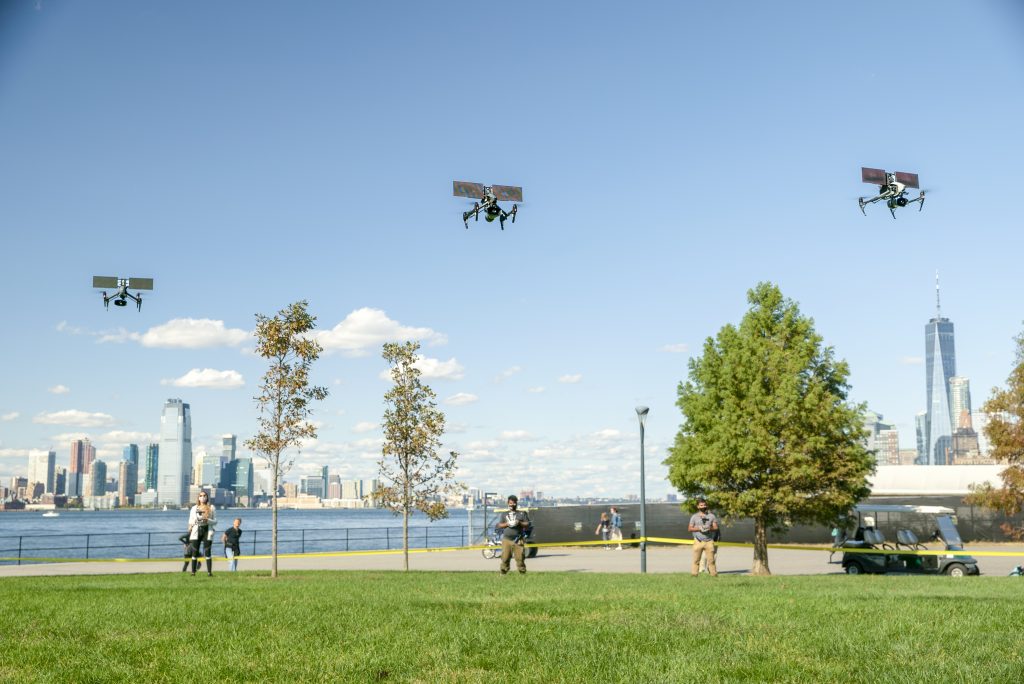
Krzysztof Wodiczko, Ustedes (Them) (2020). Multimedia installation and live performance on Governors Island, New York City, commissioned by More Art. Photo by Manuel Molina Martagon.
The practices of Scott, Helguera, and Pujol, together with many more socially engaged activist artists and collectives, operate within this fully illuminated space of Bare Art. Everything is now out there in plain sight, right alongside the profusion of every other cultural output including Pepe the Frog memes, Lolcat posts, and Doomsday prepper videos. Art has lost its centuries-old ideological privilege, and yet has gained in this process a front-row seat in a contentious struggle to rethink the way expressive, imaginative, and artistic value is generated, for whom, why, and to what ends. Finally we encounter the missing ingredient regarding the explosion of art activism today. It is not the exceptional position of high culture within society that has made this proliferation possible, but instead art’s earthbound plummet into the everyday. This is of course precisely what the early 20th-century avant-garde had proposed just about 100 years ago. Though it now arrives with a twist.
Artist Krzysztof Wodiczko brilliantly argues that the very possibility of a transformative avant-garde art, if it is to exist today, requires simultaneously “deconstructing and constructing participation through language, but also bodies, histories, affects, etc.” And perhaps we already bear witness to this process, not only with the work of Scott, Helguera, and Pujol, but also with such near-spontaneous social protest formations as Black Lives Matter, #MeToo, and Viacrucis del Migrante (Migrant Caravan). It seems we have arrived at a moment of great possibilities, and equally great risks, where art is both the name for a particular act of defiance, and the name of a $60-some-billion-dollar industry tracked by leading investment funds.
If Wodiczko is correct, and I hope he is, then we who are both true defenders and relentless critics of contemporary art must act like a cadre of hooded ninjas, or sorcerers, upholding past ideals, while coldly confronting the most abject contradictions, like irradiated apostles of an uncertain future. This is an uncomfortable, maybe even untenable, position that we will learn to live with, as mass collective agency once again impulsively erupts into public places and media spaces. Informed by oppositional lessons learned from a long-suppressed history from below, inspired by a host of once-marginalized pedagogues, and armed with a disruptive tactical technology that reanimates a socially engaged artistic agency by any means necessary, let us celebrate a haunted necromantic vanguardism that casts impossible dark-matter shadows across the brazen and bright world of bare art.
Excerpted from More Art in the Public Eye, edited by Micaela Martegani, Jeff Kasper, and Emma Drew, Duke University Press, 2019.
Gregory Sholette is a co-founder of the collectives Political Art Documentation/Distribution, REPOhistory, and Gulf Labor Coalition, as well as author of the books Dark Matter, Delirium and Resistance, and Art As Social Action with Chloë Bass, who is co-director with Sholette of the art and social justice program Social Practice CUNY.